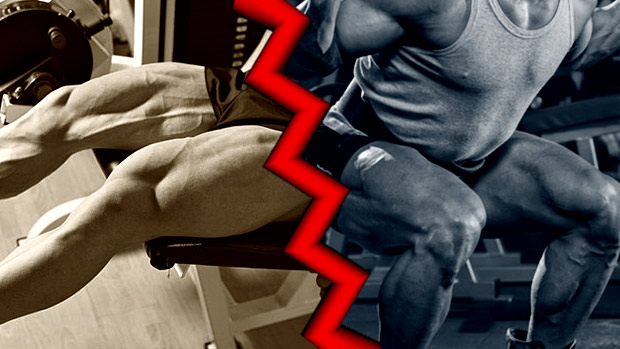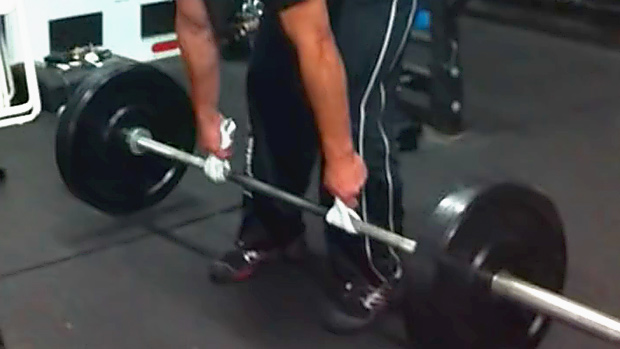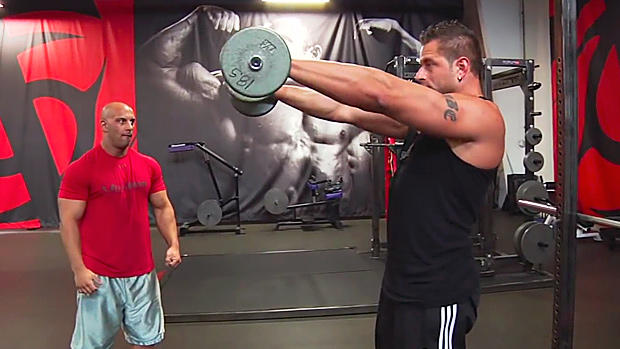The Science of Supersets
The idea of coupling exercises to increase training intensity or efficiency is about as old as the barbell itself. Supersets (exercises done back to back with no rest) and alternating sets (do an exercise, rest, then do a different one) have been around since Pangaea broke apart.
There are two main types of supersets:
- Supersets for agonist and antagonist muscle groups: This was a favorite of Arnold's for chest and back work. It's also commonly used for biceps and triceps training.
- Supersets for pre-exhausting one muscle group: This is where you start with a single-joint exercise, then with no rest move directly to a compound exercise. Leg extensions then squats, for example.
These are both fine training modalities, and the agonist versus antagonist method actually has some science behind it showing that it potentiates increases in strength performance.
But what if we throw a wrench into this method and smash a whole muscle group, train it from various angles, and save a bit of time while we're at it? It's a strategy called zig-zagging and it's a very efficient way to stimulate growth.
Bodybuilders have said for decades that to create complete development of a muscle, it needed to be trained at multiple angles. There was a time when science scoffed at this, and fell back on the size principle: since motor units were activated from smallest to largest, it was unnecessary to train multiple angles.
They argued there was no "upper chest" or "inner biceps" that could be targeted through exercise selection, and that a muscle was either being worked in its entirety or not at all. Since then, "science" has had to eat crow because research revealed that different parts of a muscle are indeed stressed more or less depending on the movement being performed. Bros for the win, yet again.
This doesn't mean you can isolate one area all together. It just means that tension distribution on a muscle is greater in some areas of the working muscle group than others. If you're striving for complete muscular development, you need more than the compound movements.
Bodybuilders don't end up with that 3D look just because of drugs. Their training modalities play a major factor in their appearance and development. And now that we've established the importance of using multiple movements to stress a muscle at different angles, let's talk about how zig-zagging sets for the same muscle group does that.
Zig-zagging is a principle that bodybuilding physiologist, Scott Stevenson, uses in his Fortitude training protocol. It's basically a type of superset where you rest between the exercises.
A typical zig-zag superset:
- Choose two different exercises for the SAME body part.
- Do the first exercise, then rest 2-3 minutes.
- Do the second exercise.
Here's where it starts to look different: Choose two exercises that stress the same muscle at different angles/lengths and avoid movement redundancy. For example, do a seated press for shoulders, rest, then do a set of lateral raises. But something like seated barbell presses then seated dumbbell presses would be redundant.
In the former, you'd use a multi-joint movement, where tension is distributed throughout a greater degree of musculature, and then you'd do a single-joint movement where tension is distributed into a more concentrated area, i.e. the lateral delts.
- After 2-3 zig-zags (supersets with rest between exercises) you'd keep the compound exercise in place, but swap out the isolation exercise. For example, replace the lateral raises with bent-over laterals for another 2-3 rounds.
This type of workout is typical for most guys seeking hypertrophy, but it eliminates the "do a movement, rest, do another set of the same movement, rest" methodology that's so prevalent in bodybuilding plans.
Note: Triceps and biceps don't really need zig-zagging, though no one is stopping you from doing it. This method mainly just applies to larger body parts, so we're going to stick with smashing the delts, back, legs, and chest.
Pick three sets of compounds for thighs, chest, and shoulders, as well as three favorite back thickness (rowing and deadlifts) and back width (vertical pulling) movements. Here are some examples. (Not a workout, just examples!)
Chest
- Incline Smith Machine Press and Pec Deck: 2 zig-zag supersets
- Incline Smith Machine Press and Flat Dumbbell Flye with accommodating resistance (add bands to the dumbbells, see video): 2 supersets
Back (Thickness)
- Below-the-Knee Rack Deadlift (see video) and Lat Pulldown: 3 supersets
- Low Cable Row and Chin-Up: 3 supersets
Back (Width)
- Lat Pulldown and Pullover: 2-3 supersets
- Chin-Up and Straight-Arm Pulldown (see video): 2-3 supersets
Quads, Hams, and Glutes
- Hack Squat and Sissy Squat: 2 supersets
- Hack Squat and Seated Leg Curl: 2 supersets
- Hack Squat and Hip Thrust: 2 supersets
1. Compound is Priority
The compound exercise is the staple of the workout and you build around it. Because you incur fatigue (duh) in the working muscle group after the isolation exercise, expect to take a hit when going back to the compound movement. In other words, you may have to adjust the weights down a bit on the second zig-zag if you have a specific target rep range in mind.
So if you hit 245 x 8 on bench press, then did flat flyes with the 40's for 10, don't expect to come back and hit 245 x 8 or more on the second superset. You could stick with the 245 and bang out what you can, or you can drop the weight for the second superset and focus on a target rep range. There's no hard and fast rule with that.
2. Create Efficiency When Possible
We don't have a lot of love for that gym bro that's doing a form of alternating sets, occupying two pieces of equipment, and taking his sweet-ass time between sets. You know the one...
- Him: "Yeah, I'm still using that, bro."
- Me: "But you're over here, and that's over there."
- Him: "I've still got dibs on it for 9 more sets."
There's a way to not be that guy. Pair things like press and lateral raise by simply bringing the dumbbells to the rack. Smith machine squats and sissy squats also work well, as do rack deadlifts and chins, because most racks have a chin-up bar.
Commit to the compound exercise and choose isolation exercises on the fly. If someone takes your delt lateral machine when you're ready to zig-zag over to it, you can do a dumbbell lateral instead or some other similar movement. Don't sweat it – you might even accidentally come up with a better combo of exercises.
3. Rotate Through The Exercises
Pick 2-3 compound movements and 2-3 isolation movements you're going to build the program around. Now rotate through those for a few months.
For example, for chest/shoulders/triceps you'd have 2-3 workouts you're rotating through that focus on different compound and different isolation exercises. Examples:
Chest/Shoulders/Triceps 1
- Incline Smith Press and Flat Dumbbell Flye
- Incline Smith Press and Cable Crossover
- Seated Press Behind-the-Neck and Lateral Raise
- Seated Press Behind-the-Neck and Bentover Lateral Raise
- Skull Crusher (no zig-zag needed)
Chest/Shoulders/Triceps 2
- Bench Press and Incline Flye
- Bench Press and Pec Deck
- Standing Press and Front Plate Raise
- Standing Press and Band Pull-Apart
- Seated Dumbbell French Press
Back/Biceps – Back Thickness Focus
- Rack Deadlifts and Chin-Up
- Rack Deadlifts and Low Cable Row
- Any Curl
Back/Biceps – Back Width Focus
- Lat Pulldown (Any Grip Width) and Pullover
- Lat Pulldown (Any Grip Width) and Straight-Arm Pulldown
- Any Curl
Legs
- Quad Focus:
- Safety Bar Squat (Heels Elevated) and Sissy Squat
- Safety Bar Squat (Heels Elevated) and Leg Extension
- Ham/Glute Focus:
- Sumo Leg Press and Leg Curl
- Sumo Leg Press and Hip Thrust
- Walking Lunge (as a finisher)
This is an awesome way to really pulverize yourself into multi-angle training submission. Zig-zagging has a high degree of training economy combined with metabolic stress and a bit of progressive overload. That's quite the delicious recipe for muscle building. Get going.




